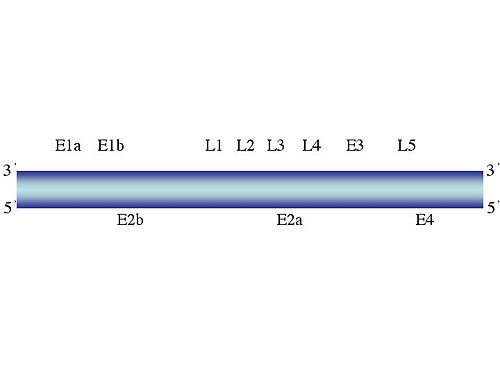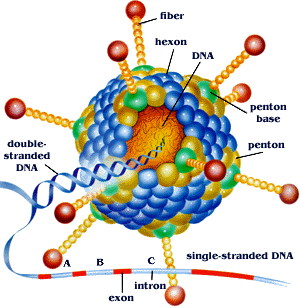Adenoviridae: Difference between revisions
imported>Idan Levi No edit summary |
imported>Idan Levi No edit summary |
||
| Line 22: | Line 22: | ||
==Cell structure and metabolism== | ==Cell structure and metabolism== | ||
The structure of an adenovirus is usually 90-100 nm in diameter. The whole virus is made up of a core, which is where the dsDNA is found, fibers external to the capsid, a capsid, and proteins. The lenght of the fibers are around 9-77.5 nm and some contain glycoproteins. The surface of the capsid is made up of 252 capsomers. Twelve of the capsomers pentons and the other 240 are hexons. The core itself is made up of a nucleoprotein complex. | The structure of an adenovirus is usually 90-100 nm in diameter. The whole virus is made up of a core, which is where the dsDNA is found, fibers external to the capsid, a capsid, and proteins. The lenght of the fibers are around 9-77.5 nm and some contain glycoproteins. The surface of the capsid is made up of 252 capsomers. Twelve of the capsomers pentons and the other 240 are hexons. The core itself is made up of a nucleoprotein complex.<br /> | ||
[[Image:Adenovirus1.gif]] | [[Image:Adenovirus1.gif]] | ||
| Line 32: | Line 32: | ||
==Application to Biotechnology== | ==Application to Biotechnology== | ||
Modern research is attempting to treat cancer by using adenovirus vectors. Much study is done on oncogenes and how to stop the rapid replication that they cause. | |||
==Current Research== | ==Current Research== | ||
Revision as of 22:13, 2 April 2008
Articles that lack this notice, including many Eduzendium ones, welcome your collaboration! |
| Adenovirus | ||||||
|---|---|---|---|---|---|---|
| Virus classification | ||||||
|
Description and significance
Adenoviruses are nonenveloped and icosahedral (contain 20 faces) viruses. They have the ability to infect various animals, including humans, canines and birds. In humans, adenoviruses are the cause of respiratory diseases. The name comes from adenoids, which means tonsils, because they were first isolated from human tonsils.
Adenoviruses are able to withstand extreme conditions, including unfavorable pH environments. Therefore, they can live outside of a host for long periods of time compared to other viruses.

Genome structure
The genome of adenoviridae consists of around 30-38 Kbp. It is linear and is made up of double stranded DNA, with no segmentation. The terminal end of the genome consists of a 55 kDa protein on every 5' end of it. The importance of this is that it enables sufficient replication of that part of the DNA. Furthermore, it is used as primers.
Cell structure and metabolism
The structure of an adenovirus is usually 90-100 nm in diameter. The whole virus is made up of a core, which is where the dsDNA is found, fibers external to the capsid, a capsid, and proteins. The lenght of the fibers are around 9-77.5 nm and some contain glycoproteins. The surface of the capsid is made up of 252 capsomers. Twelve of the capsomers pentons and the other 240 are hexons. The core itself is made up of a nucleoprotein complex.

Ecology
Like all viruses, adenoviruses require a host to reproduce. However, they are unique in the sense that they are capable of being outside of their host for longer periods of time because they are resistant to various harsh conditions. They spread from host to host by methods of either direct contact, waterborne transmission, or fecal-oral transmission.
Pathology
Adenoviruses have two phases which allow it to cause disease. First - in the early phase - the virus attaches to the host cell using its fibers. This causes the host cell to take in the adenovirus through endocytosis. As the virus makes its way to the nucleus, the virus dissasembles to allow the DNA to be released. Transcription on the viral DNA begins when it is in the nucleus. Initially, the proteins that are produced are used to regulate the translation and transcription of the viral genome. They activate different genes of the virus. Moreover, the allow the virus to survive the immune system of the host. The late phase is started as assembly proteins are made. Genes are made to assemble new viruses. At the same time, translation of the hosts mRNA is stopped by blocking the movement of host mRNA - while the mRNA of the virus is allowed to freely move across the nucleus and into the cytoplasm to be translated. As more and more viruses are made, the host cell dies and releases them.
Application to Biotechnology
Modern research is attempting to treat cancer by using adenovirus vectors. Much study is done on oncogenes and how to stop the rapid replication that they cause.
Current Research
Diagnostic and therapeutic application of telomerase-specific oncolytic adenoviral agents Toshiyoshi Fujiwara, Yasuo Urata, Noriaki Tanaka Attenuated adenovirus vector are being tested to see whether they can be a method of curing or diagnosing cancer. The activation of telomerase is a significant step in carcinogenesis. Its activation is related to human telomerase reverse transcriptase (hTERT). By attenuating adenovirus 5 vector, they made the hTERT express two proteins - E1A and E1B. Thus, "Telomelysin replicated efficiently and induced marked cell killing in a panel of human cancer cell lines, whereas replication as well as cytotoxicity was highly attenuated in normal human cells lacking telomerase activity." Furthermore, they added Green Fluorescent Protein to the vector, and showed that "TelomeScan causes viral spread into the regional lymphatic area and selectively replicates in neoplastic lesions, resulting in GFP expression in metastatic lymph nodes."
